Nagarik's Raktakarabi
Sunbeams at Midnight
Dr. Mizanur Rahman Shelley
Raktakarabi
(Red Oleanders) is one of the most touching among the timeless
creations of Rabindranath Thakur. It brings to sharp focus the
sprightly strength of the eternal human spirit against the backdrop
of the dark cruelty of monstrous organisations that have lost
their souls. The theme is instinct with rare majesty of ideas.
Consequently, it is not an easy task to stage the play and put
its message across anywhere in the world.
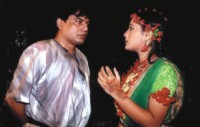 Given
the familiar limitations it is even more difficult to successfully
stage this highly appealing but complex play in present day
Bangladesh. Yet “Nagarik Nattya Sampraday” (Nagorik Drama Group)
has ventured to do exactly that and apparently achieved eminent
success. For Ataur Rahman the helmsman of the group, it has
been an act of raw courage that brought rich rewards.
Given
the familiar limitations it is even more difficult to successfully
stage this highly appealing but complex play in present day
Bangladesh. Yet “Nagarik Nattya Sampraday” (Nagorik Drama Group)
has ventured to do exactly that and apparently achieved eminent
success. For Ataur Rahman the helmsman of the group, it has
been an act of raw courage that brought rich rewards.
Nagarik's
Raktakarabi is one of the best things that has happened in the
realm of Bangali theatre of Bangladesh. A section of the informed
audience in this region earlier shared the exquisite experience
of the play as staged by the “Bahu-rupi” group of Kolkata in
the 1950s and '60s. The legendary duo of the theatre-world of
Kol-kata, Shambhu Mitra and Tripti Mitra succeeded in staging
masterly presentations of the play. During the year 1980 the
dynamism of Mustapha Manwar, then of the Bangladesh Television
(BTV) succeeded in presenting Raktakarabi on the TV screen.
In
the beginning of the third millennium and 21st century, a new
generation has stepped into youth. The youth of the 1960s and
'80s has advanced in years. In becoming older they too have
changed. It is a new generation of audience who need to be aquatinted
with the moving message of Raktakerabi. This is the need that
Ataur Rahman and his competent colleagues in the Nagarik group
have sincerely strived to fulfill.
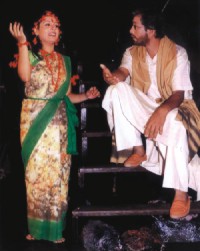 Poet
Rabindranath Tagore himself described the play as realistic;
it is neither mythological nor allegorical. He wrote, “according
to the poet's knowledge and belief the content of the drama
is real. This challenging story of life unfolds in the land
of the Mammon: Jakkhapuri. Underneath the earth in this land
lie buried treasures of Mammon. That is why, the work of digging
tunnels proceed apace there."
Poet
Rabindranath Tagore himself described the play as realistic;
it is neither mythological nor allegorical. He wrote, “according
to the poet's knowledge and belief the content of the drama
is real. This challenging story of life unfolds in the land
of the Mammon: Jakkhapuri. Underneath the earth in this land
lie buried treasures of Mammon. That is why, the work of digging
tunnels proceed apace there."
"The
King of the realm, popularly called Mokorraj gives selective
audience from behind a net that hangs on a window in the outer
walls of his palace.The Sardars (headmen) are competent and
experienced."
"The
Morols (sub-headmen) themselves were, at one time, tunnel diggers.
Their own abilities have caused their elevation. There is also
a religious leader, a priest: Goshai who depends for his subsistance
on the Sardars, despite his avowed devotion to God."
Rabindranath
further writes with penetrating sarcasm: “As in the case of
fishermen who often net creatures which are neither edible nor
saleable, but only serve to tear the net, so also in this play
a young woman called Nandini appears by sheer chance”. She is
something beyond the dark experience of Jakkhapuri. She represents
love, light and vibrant life. What she does literally is wreak
havoc on the established manners and customs of the land”.
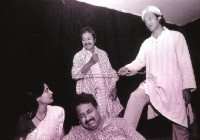 The
core content of the writing was brought fourth in clear light
by the author Tagore himself in response to some English critics'
charge of obscurity against the play. Writing in October 1925
(The Viswa Bharati Quarterly) the poet observed,... “I think,
in justice to myself, I should make it clear that it has definite
meaning which can legitimately claim literary expression. There
was a time when, in the human world, most of our important dealings
with our fellow-beings were personal dealings, and the professional
element in society was never hugely disproportionate to the
normal constitution of its life.
The
core content of the writing was brought fourth in clear light
by the author Tagore himself in response to some English critics'
charge of obscurity against the play. Writing in October 1925
(The Viswa Bharati Quarterly) the poet observed,... “I think,
in justice to myself, I should make it clear that it has definite
meaning which can legitimately claim literary expression. There
was a time when, in the human world, most of our important dealings
with our fellow-beings were personal dealings, and the professional
element in society was never hugely disproportionate to the
normal constitution of its life.
"...Today
another factor has made itself immensely evident in shaping
and guiding human destiny. It is the spirit of organisation,
which is not social in character, but utilitarian... ."
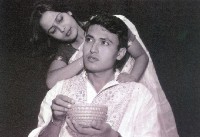 ...
But the personal man is not dead, only dominated by the organised
man. The world has become the world of Jack and Giant the Giant
who is not a gigantic man, but a multitude of men turned into
a gigantic system”.
...
But the personal man is not dead, only dominated by the organised
man. The world has become the world of Jack and Giant the Giant
who is not a gigantic man, but a multitude of men turned into
a gigantic system”.
The author
leaves us in no doubt that the essence of the glorious human
spirit is love. It is personified in the heroine, Nandini who
runs like a sparkling and lively subterranean stream in the
dark caverns of the Kingdom of Mammon, “Jakkhapuri” of the South
Asian lores.
The spirit
of the play has been exquisitely captured in the lively portrayal
of the character and personality of Nandini. Aupi Karim gives
a superb account of herself as an actress who blends with easy
elegance into the role she performs. Her faithful acting brings
the essence of Nandini's personality into full play. Ataur Rahman,
the director of Nagarik's Raktakarabi, in the role of the forlorn
ruler faithfully depicts the inner helplessness of a leader
presiding over a Leviathan that holds him in irredeemable captivity.
Rajib Dey as Gokul and Rakaet as a principal Sardar, Amal Biswas
Katha and Khaled Anwar as Morols do a splendid job manifesting
the ways of a giant of an organisation that runs and controls
a dark realm. Fakhruzzaman Chowdhury as Gonsai, through his
engaging acting, brings to humorous focus the hypocrisy of the
self proclaimed man of God.
Ananta Hira
in the role of the Professor, as usual, performes splendidly.
Again, Shirin Bakul and Shabnam Shathi acting alternately, adequately
perform their part. Lutfur Rahman Goerge in his portrayal of
Fagulal easily reaches the audiences heart.
Khaled Khan
in the role of Bishu deserves special mention. He did a splendid
job by unearthing different layers of human sensitivity in his
dealing with Nandini and other inmates of Jakkhapuri.
Rawnak Hasan
as the Junior Sardar, Sandeepan Das as Puran Bagish, Abdur Rashid
as Garju Pahloan, Omar Ayaz Oni as the Mejo (Deputy) Sardar
- all contribute significantly to the total success of the performance.
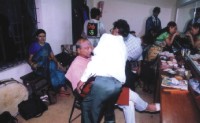 Despite
severe constraints of the Mahila Samity Auditorium, Md. Saiful
Islam does a commendable job in designing the stage. K B Azad
in his direction of background sound and music, Aminul Islam
Hiro in Choreography, Aditi Mohsin in training of music and
Azizur Rahman Tuhin in playback, all contribute to the overall
success of the play. Masud Kazi in designing costumes and stage
decoration, Kazi Raquib in the design of poster and souvenir,
Nasirul Haque Khokon in direction of lighting, Tapan Kumar Das
in makeup, all add ably to the creation of the grand harmony
manifest in Nagorik's Raktakabari.
Despite
severe constraints of the Mahila Samity Auditorium, Md. Saiful
Islam does a commendable job in designing the stage. K B Azad
in his direction of background sound and music, Aminul Islam
Hiro in Choreography, Aditi Mohsin in training of music and
Azizur Rahman Tuhin in playback, all contribute to the overall
success of the play. Masud Kazi in designing costumes and stage
decoration, Kazi Raquib in the design of poster and souvenir,
Nasirul Haque Khokon in direction of lighting, Tapan Kumar Das
in makeup, all add ably to the creation of the grand harmony
manifest in Nagorik's Raktakabari.
The care
and devotion of the entire team led by Ataur Rahman diligently
contribute to Nagorik's success. Pitfalls and inadequacies are
there but the entire experience is so enriching that those shortcomings
are easily forgotten.
As a matchless,
poetic creation Raktakarabi is an exercise to bring penetrating
shafts of loving sunlight in the heart of darkness. Nagarik's
performance ably strives to do justice to this masterly creation
and succeeds in projecting radiant sunbeams at dark midnight.
* The author,
a noted thinker, litterateur, writer and social scientist, is
the founder Chairman, Centre for Development Research, Bangladesh
(CDRB), Overseas Director, American Institute of Bangladesh
Studies (AIBS), Editor, quarterly “Asian Affairs”.

 Given
the familiar limitations it is even more difficult to successfully
stage this highly appealing but complex play in present day
Bangladesh. Yet “Nagarik Nattya Sampraday” (Nagorik Drama Group)
has ventured to do exactly that and apparently achieved eminent
success. For Ataur Rahman the helmsman of the group, it has
been an act of raw courage that brought rich rewards.
Given
the familiar limitations it is even more difficult to successfully
stage this highly appealing but complex play in present day
Bangladesh. Yet “Nagarik Nattya Sampraday” (Nagorik Drama Group)
has ventured to do exactly that and apparently achieved eminent
success. For Ataur Rahman the helmsman of the group, it has
been an act of raw courage that brought rich rewards.  Poet
Rabindranath Tagore himself described the play as realistic;
it is neither mythological nor allegorical. He wrote, “according
to the poet's knowledge and belief the content of the drama
is real. This challenging story of life unfolds in the land
of the Mammon: Jakkhapuri. Underneath the earth in this land
lie buried treasures of Mammon. That is why, the work of digging
tunnels proceed apace there."
Poet
Rabindranath Tagore himself described the play as realistic;
it is neither mythological nor allegorical. He wrote, “according
to the poet's knowledge and belief the content of the drama
is real. This challenging story of life unfolds in the land
of the Mammon: Jakkhapuri. Underneath the earth in this land
lie buried treasures of Mammon. That is why, the work of digging
tunnels proceed apace there." The
core content of the writing was brought fourth in clear light
by the author Tagore himself in response to some English critics'
charge of obscurity against the play. Writing in October 1925
(The Viswa Bharati Quarterly) the poet observed,... “I think,
in justice to myself, I should make it clear that it has definite
meaning which can legitimately claim literary expression. There
was a time when, in the human world, most of our important dealings
with our fellow-beings were personal dealings, and the professional
element in society was never hugely disproportionate to the
normal constitution of its life.
The
core content of the writing was brought fourth in clear light
by the author Tagore himself in response to some English critics'
charge of obscurity against the play. Writing in October 1925
(The Viswa Bharati Quarterly) the poet observed,... “I think,
in justice to myself, I should make it clear that it has definite
meaning which can legitimately claim literary expression. There
was a time when, in the human world, most of our important dealings
with our fellow-beings were personal dealings, and the professional
element in society was never hugely disproportionate to the
normal constitution of its life.  ...
But the personal man is not dead, only dominated by the organised
man. The world has become the world of Jack and Giant the Giant
who is not a gigantic man, but a multitude of men turned into
a gigantic system”.
...
But the personal man is not dead, only dominated by the organised
man. The world has become the world of Jack and Giant the Giant
who is not a gigantic man, but a multitude of men turned into
a gigantic system”.  Despite
severe constraints of the Mahila Samity Auditorium, Md. Saiful
Islam does a commendable job in designing the stage. K B Azad
in his direction of background sound and music, Aminul Islam
Hiro in Choreography, Aditi Mohsin in training of music and
Azizur Rahman Tuhin in playback, all contribute to the overall
success of the play. Masud Kazi in designing costumes and stage
decoration, Kazi Raquib in the design of poster and souvenir,
Nasirul Haque Khokon in direction of lighting, Tapan Kumar Das
in makeup, all add ably to the creation of the grand harmony
manifest in Nagorik's Raktakabari.
Despite
severe constraints of the Mahila Samity Auditorium, Md. Saiful
Islam does a commendable job in designing the stage. K B Azad
in his direction of background sound and music, Aminul Islam
Hiro in Choreography, Aditi Mohsin in training of music and
Azizur Rahman Tuhin in playback, all contribute to the overall
success of the play. Masud Kazi in designing costumes and stage
decoration, Kazi Raquib in the design of poster and souvenir,
Nasirul Haque Khokon in direction of lighting, Tapan Kumar Das
in makeup, all add ably to the creation of the grand harmony
manifest in Nagorik's Raktakabari.